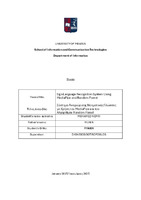Sign language recognition system using MediaPipe and random forest
Σύστημα αναγνώρισης νοηματικής γλώσσας με χρήση του MediaPipe και του αλγορίθμου random forest

Bachelor Dissertation
Author
Nemri, Mohamed Munir
Date
2025-01View/
Keywords
Machine learning ; MediaPipe ; Random forest algorithm ; Sign language recognition ; PythonAbstract
Sign language is a vital communication tool for individuals with hearing or speech impairments. However, the lack of widespread understanding of sign language often creates a communication gap. This research focuses on developing a real-time sign language recognition system using MediaPipe for landmark extraction and a Random Forest classifier for gesture recognition. The primary objective is to bridge the communication barrier by enabling automatic sign language interpretation.
This project is structured into four key stages: data collection, dataset creation, model training, and testing/inference. Custom sign language data was collected manually using a webcam, capturing various gestures such as "hello," "thanks," and "car." MediaPipe was utilized to extract 21 hand landmarks from the images, reducing dimensionality and focusing on key features for classification. The processed data was stored as numerical coordinates paired with corresponding labels. A Random Forest algorithm was chosen due to its interpretability, robustness, and high efficiency for small to medium-sized datasets.
The system achieved promising results, with an accuracy of over 90% on the test dataset, demonstrating its potential for real-world applications. Real-time testing confirmed the model's ability to predict gestures accurately based on live video input. While challenges such as variability in hand gestures and lighting conditions remain, this study provides a foundation for future enhancements, including dynamic gesture recognition and integration of additional body landmarks.
This research emphasizes the importance of customized datasets, robust machine learning models, and real-time inference systems in addressing accessibility issues. Future work aims to expand the dataset, incorporate temporal data for dynamic gestures, and deploy the system on portable devices for enhanced usability.


